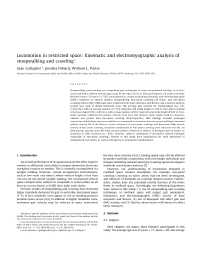Mining Publication: Locomotion in Restricted space: Kinematic and Electromyographic Analysis of Stoopwalking and Crawling
Original creation date: January 2011
Stoopwalking and crawling are compulsory gait techniques in some occupational settings, as in low-seam coal mines (where vertical space may be less than 122cm). Nine participants, six males and three females (mean=35 years+17 SD), participated in a study examining kinematic and electromyographic (EMG) responses to natural cadence stoopwalking, four-point crawling (all fours), and two-point crawling (knees only). EMG data were collected from knee extensors and flexors, and a motion analysis system was used to obtain kinematic data. The average gait velocity for stoopwalking was 1.01 (+/-0.32)m/s with an average cadence of 112.8steps/min and stride length of 1.04m. Four-point crawling velocity averaged 0.50 (+/-0.20)m/s, with average cadence of 86.3steps/min and stride length of 0.69m. Two-point crawling exhibited the slowest velocity (0.32m/s) and shortest stride length (0.40m); however, cadence was greater than four-point crawling (96.8steps/min). EMG findings included prolonged contraction of both knee extensors and flexors (compared to normative data on normal walking), increased relative activity SD of the flexors (versus extensors) in two-point crawling, and decreased thigh muscle activity in four-point crawling. Interlimb coordination in four-point crawling trials indicated trot-like, no limb pairing, and near pace-like limb contact patterns. Presence or absence of kneepads had no impact on kinematic or EMG measures (p>0.05); however, subjects complained of discomfort without kneepads (especially in two-point crawling). Results of this study have implications for work performed in underground coal mines, as well as emergency or evacuation considerations.
Authors: S Gallagher, JP Pollard, WL Porter
Peer Reviewed Journal Article - January 2011
NIOSHTIC2 Number: 20037840
Gait & Posture 2011 Jan; 33(1):71-76
See Also
- Characteristics of Gait in Restricted Vertical Space Versus Unrestricted Walking
- Effects of Lifting in Four Restricted Postures
- The Effects of Restricted Workspace on Lumbar Spine Loading
- Electromyography of the Thigh Muscles during Lifting Tasks in Kneeling and Squatting Postures
- Lifting in Stooped and Kneeling Postures: Effects on Lifting Capacity, Metabolic Cost, and Electromyography of Eight Trunk Muscles
- Motion Editing and Reuse Techniques and Their Role in Studying Events Between a Machine and its Operator
- Pressure Distribution on the Anatomic Landmarks of the Knee and the Effect of Kneepads
- Pressures Applied to Anatomical Landmarks of the Knee While in Kneeling Postures
- Trunk Extension Strength and Muscle Activity in Standing and Kneeling Postures
- Working in Unusual or Restricted Postures
- Content source: National Institute for Occupational Safety and Health, Mining Program


 ShareCompartir
ShareCompartir
